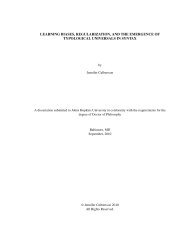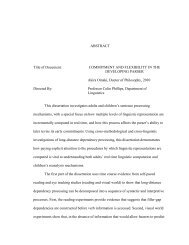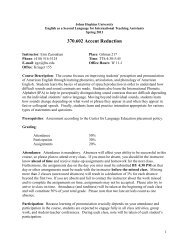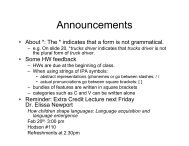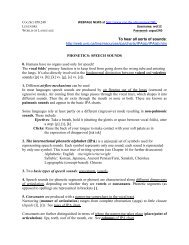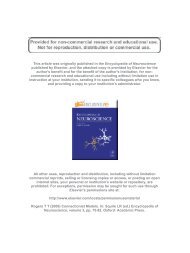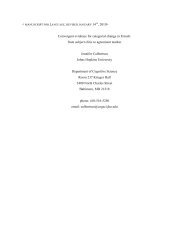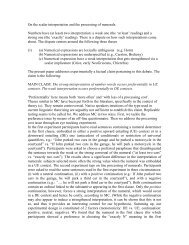Children's Comprehension and Production of Compound Nouns in ...
Children's Comprehension and Production of Compound Nouns in ...
Children's Comprehension and Production of Compound Nouns in ...
You also want an ePaper? Increase the reach of your titles
YUMPU automatically turns print PDFs into web optimized ePapers that Google loves.
Children’s <strong>Comprehension</strong> <strong>and</strong> <strong>Production</strong> <strong>of</strong> <strong>Compound</strong> <strong>Nouns</strong> <strong>in</strong> Korean<br />
It is a well-known fact that compound nouns formed from root plus root nouns (e.g., birthday<br />
party) have various mean<strong>in</strong>gs <strong>in</strong> English <strong>and</strong> therefore might cause the learnability problem to<br />
children (Clark 1981, Clark et al. 1985, Fabb 1998, Gottfried 1997). This study aims to exam<strong>in</strong>e<br />
whether Korean-speak<strong>in</strong>g children aged 3 to 4 know that compound nouns refer to <strong>in</strong>teract<strong>in</strong>g<br />
objects, <strong>and</strong> whether they know the subcatgorization function <strong>of</strong> compound nouns, based on<br />
production <strong>and</strong> comprehension task.<br />
Interest<strong>in</strong>g factors related to children’s acquisition <strong>of</strong> compound nouns are whether they<br />
underst<strong>and</strong> the various mean<strong>in</strong>g <strong>of</strong> compound nouns, <strong>and</strong> whether they acquire the<br />
subcategorization function <strong>of</strong> compound nouns. For example, a cereal box denotes a box<br />
conta<strong>in</strong><strong>in</strong>g cereal. A rabbit hat can always be a hat, but it could be many k<strong>in</strong>ds <strong>of</strong> hats, <strong>in</strong>clud<strong>in</strong>g<br />
a hat with a rabbit on it or a hat that a rabbit wears. In addition, compound nouns <strong>in</strong> English<br />
usually denote <strong>in</strong>teract<strong>in</strong>g two objects. Clark et al. (1985) reported that English-speak<strong>in</strong>g<br />
children prefer to use compounds when describ<strong>in</strong>g two objects that were <strong>in</strong>herently related (such<br />
as a pumpk<strong>in</strong> house for a house <strong>in</strong> the shape <strong>of</strong> a pumpk<strong>in</strong>) or semi-<strong>in</strong>herently related rather than<br />
for objects that were accidentally related (such as frog fan for a frog posed on a fan). In spite <strong>of</strong><br />
the fact that the compounds may be different <strong>in</strong> the semantic relations between the two nouns,<br />
one common fact is that they all serve a subcategorization function. That is, compounds formed<br />
by noun plus noun are generally composed <strong>of</strong> a head noun <strong>and</strong> modify<strong>in</strong>g noun. For example, <strong>in</strong><br />
a rabbit hat, the rightmost noun hat as a head <strong>and</strong> the leftmost noun rabbit function as a<br />
modify<strong>in</strong>g noun. This common fact is generally found across languages, regardless <strong>of</strong> whether<br />
languages are right-headed or left-headed (Fabb 1998). Previous studies have shown that the<br />
frequency <strong>and</strong> complexity <strong>of</strong> morphology <strong>in</strong> the <strong>in</strong>put language play an important role <strong>in</strong><br />
children’s acquisition <strong>of</strong> the subcategorization function <strong>of</strong> compound nouns (Berman & Clark<br />
1989, Clark 1993, Clark & Berman 1984, Clark et al. 1985, Mellenius 1996, Nicoladis 1999).<br />
A recent study by Nicoladis (2003) exam<strong>in</strong>ed whether English-speak<strong>in</strong>g children could<br />
underst<strong>and</strong> the mean<strong>in</strong>g <strong>of</strong> compound nouns that refer to <strong>in</strong>teract<strong>in</strong>g objects. She found that 3year-old<br />
children <strong>and</strong> 4-year-old children equally produced compounds to name two <strong>in</strong>teract<strong>in</strong>g<br />
objects (70% vs. 80%), whereas 3-year-old children less understood that compound nouns refer<br />
to two <strong>in</strong>teract<strong>in</strong>g objects than 4-year-old children (52.2% vs. 67.5%). Her f<strong>in</strong>d<strong>in</strong>gs seem to<br />
contrast with the previous literatures <strong>in</strong> that 3-year-old children's production was better than their<br />
comprehension. It has been reported that children's comprehension <strong>and</strong> production <strong>of</strong> compound<br />
nouns usually occurred at approximately the same age (Clark 1981, Clark et al. 1985, Gottfried<br />
1997), whereas comprehension <strong>of</strong> the form exceeds production, when compound nouns <strong>in</strong>volve<br />
complex morphology (Berman & Clark 1987, 1989). Thus, it is an open question whether<br />
children speak<strong>in</strong>g other languages show a reverse pattern <strong>of</strong> mismatch between comprehension<br />
<strong>and</strong> production. In addition, a mismatch between language production <strong>and</strong> comprehension has<br />
been widely reported <strong>in</strong> both the language acquisition literature <strong>and</strong> the neurol<strong>in</strong>guistic literature.<br />
These previous studies have suggested that children's comprehension usually precedes their<br />
production <strong>in</strong> development.<br />
This study partially replicated Nicoladis' (2003) experiment to <strong>in</strong>vestigate whether Koreanspeak<strong>in</strong>g<br />
children might know that compound nouns usually refer to two <strong>in</strong>teract<strong>in</strong>g objects. This<br />
study further allowed us to f<strong>in</strong>d out whether children's production <strong>of</strong> novel compound nouns<br />
exceeds their comprehension <strong>of</strong> compound nouns cross-l<strong>in</strong>guistically. In addition, I <strong>in</strong>vestigated<br />
whether Korean-speak<strong>in</strong>g children at an early age might acquire the subcategorization function
<strong>of</strong> compound nouns. 30 Korean-speak<strong>in</strong>g children aged 3 to 4 participated <strong>in</strong> this study. As <strong>in</strong> the<br />
experiment by Nicoladis (2003), each child was asked to do two tasks: (1) compound production<br />
<strong>and</strong> (2) compound comprehension. First, the compound production task <strong>in</strong>cluded semi-<strong>in</strong>herently<br />
related objects, that is, <strong>in</strong>teract<strong>in</strong>g objects, such as flowers decorat<strong>in</strong>g chairs. The children were<br />
asked to look at one picture <strong>of</strong> multiple th<strong>in</strong>gs, then another picture <strong>of</strong> multiple th<strong>in</strong>gs <strong>and</strong> f<strong>in</strong>ally<br />
to name the third picture (a comb<strong>in</strong>ation <strong>of</strong> the previous two pictures). Next, on the compound<br />
comprehension task, the children were shown an array <strong>of</strong> four different pictures, separated by<br />
l<strong>in</strong>es. All pictures <strong>in</strong>cluded <strong>in</strong> the comprehension were different from those <strong>in</strong> the production<br />
task. The pictures describe each th<strong>in</strong>g alone, the th<strong>in</strong>gs comb<strong>in</strong>ed <strong>in</strong> some way <strong>and</strong> the th<strong>in</strong>gs<br />
next to each other. The children were asked to po<strong>in</strong>t to the named object <strong>in</strong> the array. Both the<br />
production <strong>and</strong> comprehension task were conducted on a portable computer. In addition, the 10<br />
test items <strong>and</strong> two filters for each task were also given to the participants.<br />
Results from the study showed that the 3-year-old <strong>and</strong> the 4-year-old children equally<br />
understood the mean<strong>in</strong>g <strong>of</strong> compound nouns (83.3% vs. 94.7%). In contrast with the<br />
comprehension task, 3-year-old children produced less compound nouns to name two <strong>in</strong>teract<strong>in</strong>g<br />
objects than 4-year-old children (42.7% vs. 83.3%). Therefore, these results demonstrate that<br />
Korean-speak<strong>in</strong>g children's knowledge <strong>of</strong> produc<strong>in</strong>g compound nouns cont<strong>in</strong>ues to develop<br />
throughout the preschool years, even though their knowledge <strong>of</strong> the mean<strong>in</strong>g <strong>of</strong> compound nouns<br />
appeared very early. In contrast with the previous study by Nicoladis (2003), the present study<br />
further shows that children's comprehension exceeds their production level. F<strong>in</strong>ally, it shows that<br />
the 3-year-old children preferred to choose the head noun rather than choose the modify<strong>in</strong>g noun<br />
when they made a s<strong>in</strong>gle-word response, suggest<strong>in</strong>g that they know the subcategorization<br />
function <strong>of</strong> compound nouns.<br />
References<br />
Berman, Richard. 1987. A developmental rout: Learn<strong>in</strong>g about the form <strong>and</strong> use <strong>of</strong> complex<br />
nom<strong>in</strong>als <strong>in</strong> Hebrew. L<strong>in</strong>guistics 25, 1057-1085.<br />
Berman, Richard., <strong>and</strong> Clark, Eve. 1989. Learn<strong>in</strong>g to use compounds for contrast: Data from<br />
Hebrew. First Language 9, 247-270.<br />
Clark, Eve. 1993. The lexicon <strong>in</strong> acquisition. Cambridge: Cambridge University Press.<br />
Clark, Eve., <strong>and</strong> Berman, Richard. 1988. Types <strong>of</strong> l<strong>in</strong>guistic knowledge: Interpret<strong>in</strong>g <strong>and</strong><br />
produc<strong>in</strong>g compound nouns. Journal <strong>of</strong> Child Language 14, 547-567.<br />
Clark, Eve., <strong>and</strong> Berman, Richard. 1984. Structure <strong>and</strong> use <strong>in</strong> the acquisition <strong>of</strong> word formation.<br />
Language 60, 542-590.<br />
Fabb, Nigel. 1998. <strong>Compound</strong><strong>in</strong>g. The h<strong>and</strong>book <strong>of</strong> morphology, eds. by Spencer Andrew &<br />
Gottfried, Gail. 1997. Comprehend<strong>in</strong>g compounds: Evidence for metaphoric skill? Journal <strong>of</strong><br />
Child Language 24, 163-186.<br />
Mellunius, Iris. 1996. <strong>Children's</strong> comprehension <strong>of</strong> Swedish nom<strong>in</strong>al compounds. <strong>Children's</strong><br />
language, eds. by Johnson Carolyn & Gilbert John, 167-182. Mahwah, NJ: Erlbaum.<br />
Nicoladis, Elena. 2003. What compound nouns mean to preschool children. Bra<strong>in</strong> <strong>and</strong> Language<br />
84, 38-49.



